About 1,000 manatees piled together in a Florida park, setting a breathtaking record
ORANGE CITY, FLORIDA – As the rising sun peeks through the trees along the Blue Spring run on cold winter mornings, park rangers peer down into the water, counting the Florida manatees basking in their version of a hot tub.
On Jan. 21, a prolonged cold snap with temperatures in the 30s had plunged the waters of the adjacent St. Johns River into the 50s. Fleeing the chilly river, herds of sea cows crowded into the warmer waters of the spring run.
Given the clear, glassy conditions and the hundreds of manatees crowded together and floating on top of each other – park rangers suspected a possible record count. They doubled up, having two rangers each count along the run, which meanders four-tenths of a mile from the spring, where the water bursts from an underground cavern, to the river.
Their final tally – 932 – didn’t just set a record. It rocketed past previous records, even the 736 they counted on New Year’s Day. It’s a far cry from the single-day record of 49 manatees celebrated 40 years ago, and more than twice as many manatees as the single day record set just 10 years ago.
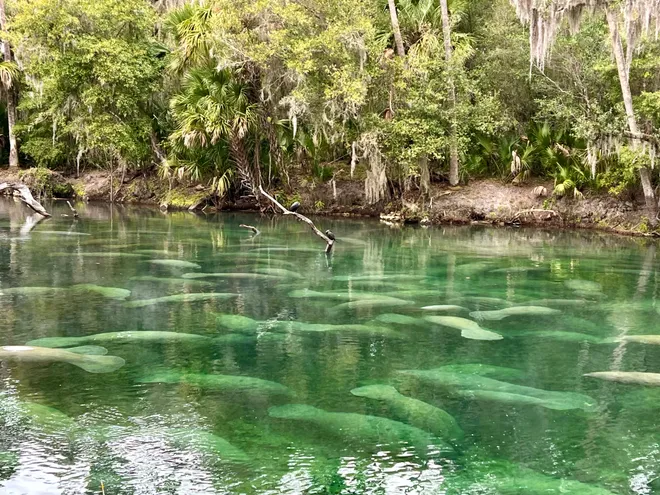
The new record is breathtaking and incredible for those who have watched over and rooted for these animals for decades.
"Thrilling and nearly unbelievable!” said John Bengston, a federal wildlife ecologist in Alaska. When Bengston completed his doctoral research on manatees in the St. Johns River in 1981, only 35 of the bewhiskered marine mammals were seen in the spring run during a record high single day count.
“Those high numbers are heartening, and a tribute to the conservation efforts and awareness of scientists, natural resource managers, and the public over the past several decades,” Bengston told USA TODAY.
Previously:See the iconic Florida manatees as they keep fighting for survival
The thriving manatee population in the St. Johns is rooted in a range of protective efforts taken over decades, often through protracted legal battles and contentious public meetings.
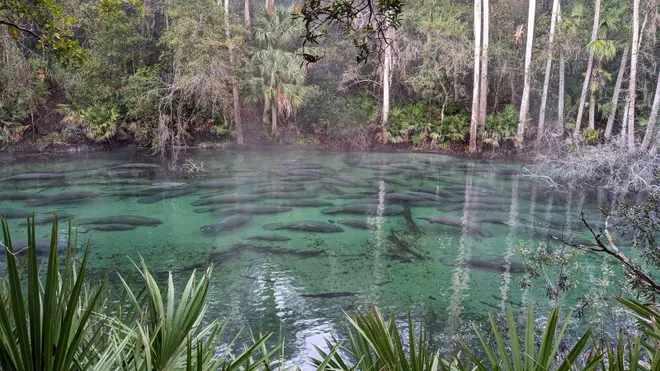
The numbers show those hard-fought protective measures are working, said David Hankla, a retired U.S. Fish and Wildlife Service field office director and veteran of some of those bitter battles.
“That’s what you’d expect for an animal not experiencing unnatural mortality,” Hankla said. “I suspect (the St. Johns) is one of the safer places to be for manatees," Hankla said.
At a state scale, “manatees have done extraordinarily well,” he said. In the early 1990s, the population was estimated at around 1,500. Last fall, Florida officials estimated the state’s manatee population at between 8,350 and 11,730, based on an assessment from 2021-2022.
Florida manatees share the state's waters with a million registered vessels and almost 22 million people. While the St. Johns manatees thrive under protected conditions, others face great peril.
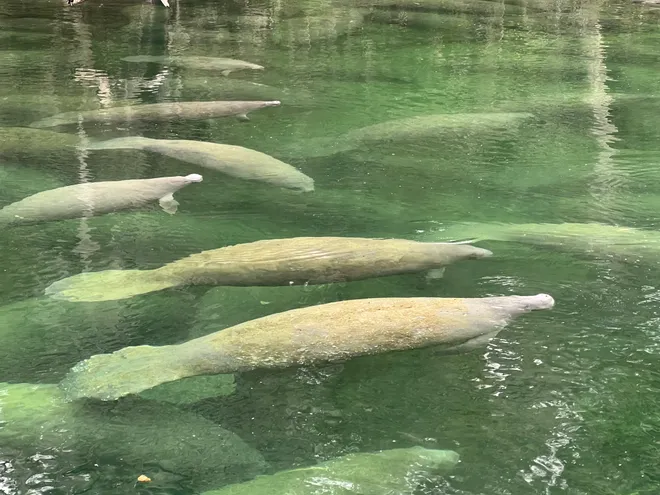
In the Indian River Lagoon, on the state's east coast, more than 1,000 manatees died over a two-year span between 2020-2022, many starving from a lack of healthy seagrass after years of massive algal blooms. Poor water quality from a variety of contributing factors is blamed.
More:Florida's starving manatees reflect troubles in coastal ecosystems around the globe
Manatees also see higher death rates on the state’s southwest coast, where they contend with busy waters, red tide algal blooms and other water quality problems.
Federal officials downlisted manatees from endangered to threatened in 2017, but announced last October they will review whether the manatee should be considered endangered again, given the increase in deaths in 2021 and 2022.
Sea cows come in from the cold, get counted
Susceptible to cold stress when water temperatures drop below 68 degrees, the manatees are attracted to Blue Spring because its waters can be 20 degrees or more warmer than the river.
Although it's commonly repeated that the spring water is “a constant” 72 or 73, U.S. Geological Survey data shows the water is warming. Temperatures in the spring run now range from 73.5 - 76.
Once they arrive, counting living animals stacked up on top of each other underwater isn't always an exact science, said Connor Wagner, park service specialist at Blue Spring.
The park rangers start early, just after first light and before the park opens, counting from boardwalks and overlooks while the manatees are undisturbed and still.
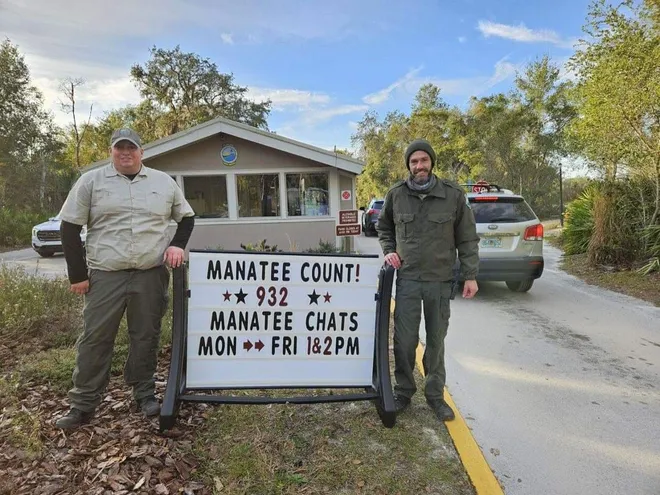
Researchers with the Save The Manatee Club also count manatees in the spring run almost daily and work to identify individual animals. One of those, Wayne Hartley, was a park specialist at Blue Spring before retiring.
He has paddled a canoe among the sea cows for more than 40 years, identifying individuals based on unique propeller scars and other body characteristics. These days he’s amazed by the number of manatees he can’t identify because they don’t have any prop scars.
On the day the park counted 932, Hartley and colleague Cora Berchem got into the water about an hour after the park rangers started, after the manatees had begun to move around and the wind picked up. Hartley said they counted nearly 700 manatees.
Sometimes the park's count is higher, sometimes the club's count is higher, he said. "Sometimes you see better from the boardwalk. Sometimes you see better from the canoe."
Overall this season, Hartley and a colleague have identified more than 800 individual manatees, including more than 80 calves.
Such numbers are astonishing to Hartley, and to the many biologists, advocates and elected officials who survived the battles that set the stage for this success story.
Local resident Arnette Sherman visits the park a few days a week. It's "thrilling to see so many manatees at one time," Sherman said.
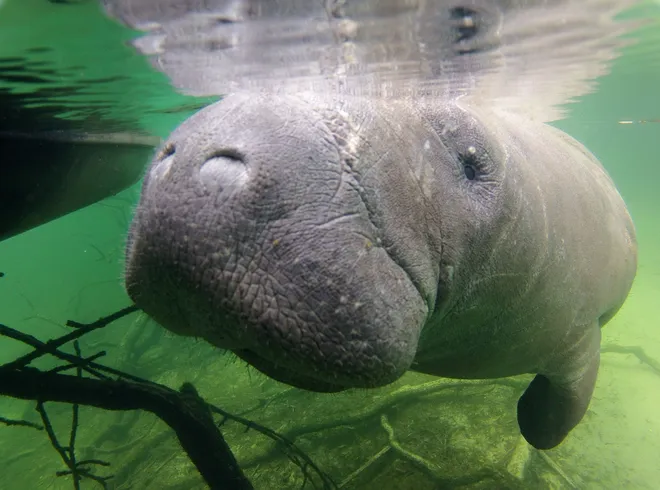
Saving manatees in the St. Johns River
Manatees have been protected in Florida since the late 1800s and were among 70 animals added to the nation's first endangered species list in 1967.
But many credit acclaimed oceanographer Jacques Cousteau with riveting public attention on manatees. Cousteau visited Blue Spring, then a privately owned fish camp in 1971, filming the animals' scarred backs and people trying to ride them. Months after the episode aired on "The Undersea World of Jacques Cousteau” in January 1972, the state bought the spring.
By 1989, Florida had become a legal and political battleground as government agencies – prodded by the Save the Manatee Club and other nonprofits – worked to enact protections. The single day high count at Blue Spring that year was 57 manatees.
The state ordered key counties to write protection plans, with boat speed limits to curtail collisions in areas frequented by manatees. The plan was particularly contentious in Volusia County, home of Blue Spring.
Local, state and federal officials, along with advocates and boaters, tussled over boat speeds for more than a decade.
Boaters and fishermen were concerned about economic impacts and argued they wouldn’t be able to cover as much ground between fishing spots. Bumper stickers cropped up proclaiming: "Welcome to Florida, where manatees are more precious than children." At one point, an elected official exclaimed in angry frustration that the county should “open a manatee canning factory.”
But the gruesome vessel-related deaths of two manatees in the St. Johns in 1991 added fuel to the push to protect the animals. One of those, Sweet Gums, an animal featured in the manatee club's adopt-a-manatee program, suffered five deep gashes from a propeller, her spine severed in two places.
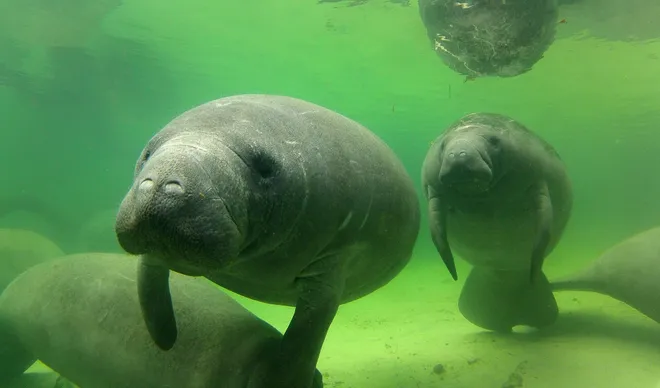
Similar battles were waged for a decade over plans to restore the spring’s water flow, which forced local utilities to find alternatives to meet the water needs of a rapidly growing population. And, the state park angered swimmers when it closed the water to people during the winter to give the manatees space.
In those contentious years, 800 or 900 manatees in the spring would have seemed “outlandish,” Hankla said. But together, the measures accomplished their purpose, creating a haven where the animals thrive.
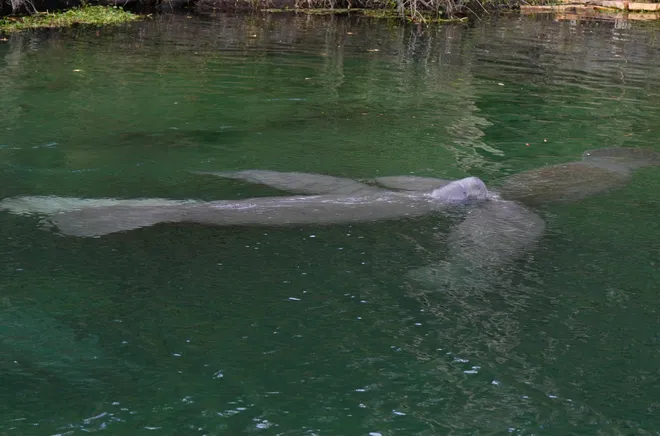
Looking to the future
Today Blue Spring State Park attracts about 700,000 visitors a year, more than half during the winter, and the wait to get into the park on the busiest days may take hours. On the river, boaters and anglers share the water with ecotourists viewing the abundant wildlife.
The manatee numbers show the protective measures are working, Hankla said. But if the water quality or quantity diminishes, it’s a problem, he said. “That’s what we’ve seen happen in the Indian River.”
The state could go a step further to help manatees in the St. Johns, he said. They could finally dismantle the Rodman Dam about 46 miles north of Blue Spring on the Ocklawaha River.
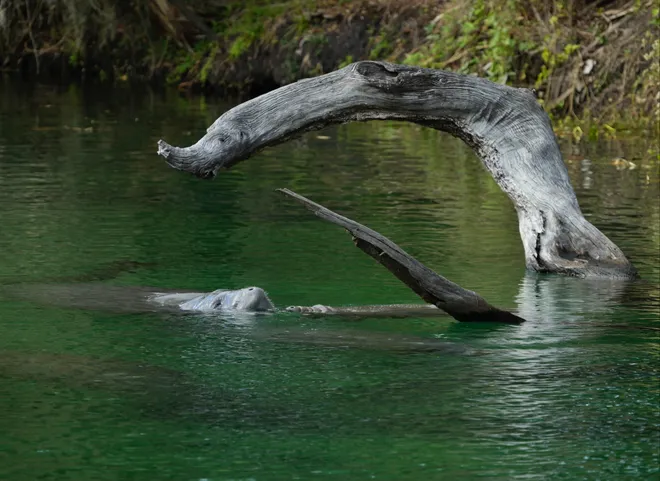
Removing the dam would give manatees unfettered access to the Ocklawaha, a major tributary to the St. Johns. That action has long been controversial with fishermen and some local elected officials, and so far the opposition has been victorious.
But, if the dam were removed, or if the lock operation was changed, Hankla said the Ocklawaha could support a “pretty substantial” number of manatees.
“It wouldn’t require you to do anything other than let them in,” he said. “That’s a pretty significant opportunity.”
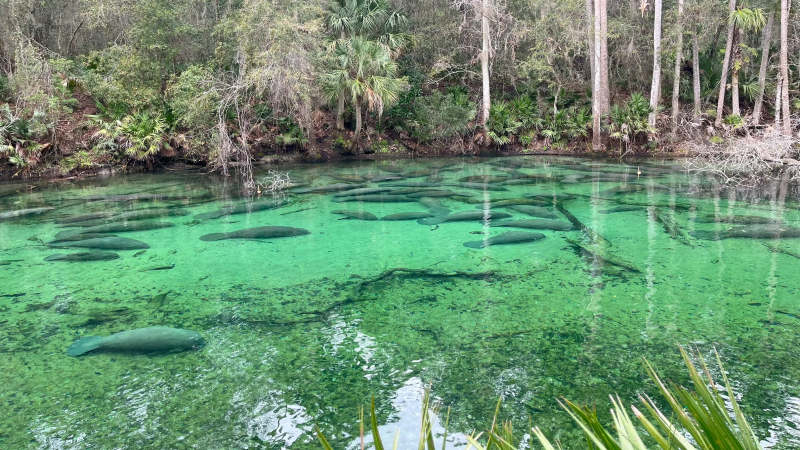
Disclaimer: The copyright of this article belongs to the original author. Reposting this article is solely for the purpose of information dissemination and does not constitute any investment advice. If there is any infringement, please contact us immediately. We will make corrections or deletions as necessary. Thank you.






